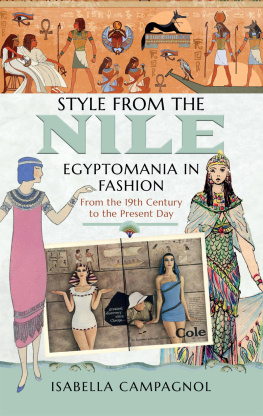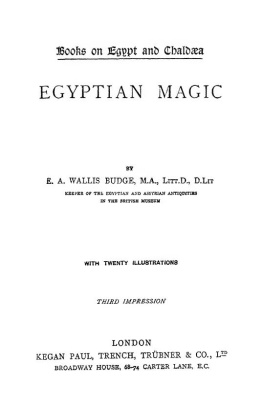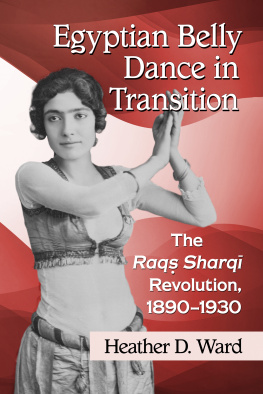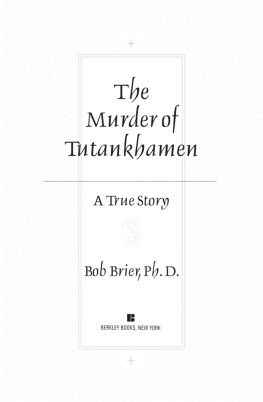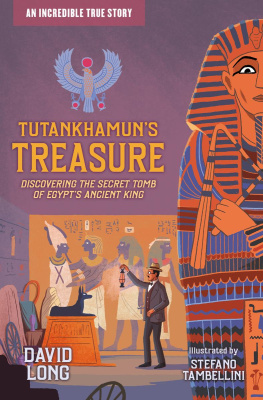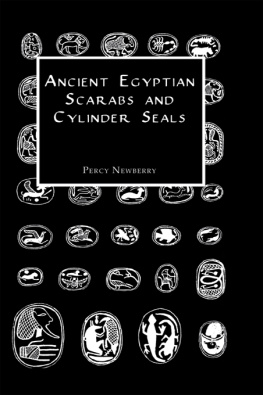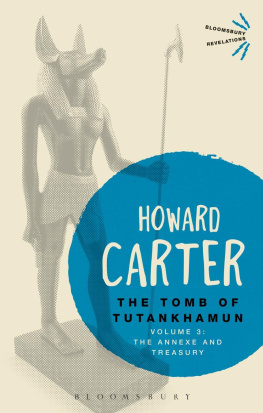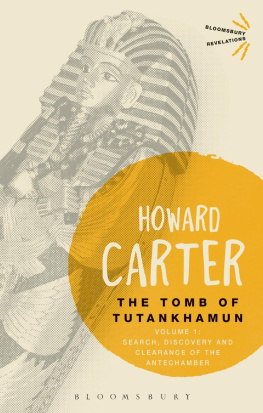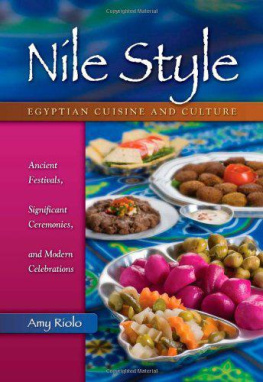Pagebreaks of the print version

Style from the Nile
Style from the Nile
Egyptomania in Fashion from the 19th Century to the Present Day
ISABELLA CAMPAGNOL
First published in Great Britain in 2022 by
PEN AND SWORD HISTORY
An imprint of
Pen & Sword Books Ltd
Yorkshire Philadelphia
Copyright Isabella Campagnol, 2022
ISBN 978 1 39909 807 6
eISBN 978 1 39909 808 3
Mobi ISBN 978 1 39909 808 3
The right of Isabella Campagnol to be identified as Author of this work has been asserted by her in accordance with the Copyright, Designs and Patents Act 1988.
A CIP catalogue record for this book is available from the British Library.
All rights reserved. No part of this book may be reproduced or transmitted in any form or by any means, electronic or mechanical including photocopying, recording or by any information storage and retrieval system, without permission from the Publisher in writing.
Pen & Sword Books Limited incorporates the imprints of Atlas, Archaeology, Aviation, Discovery, Family History, Fiction, History, Maritime, Military, Military Classics, Politics, Select, Transport, True Crime, Air World, Frontline Publishing, Leo Cooper, Remember When, Seaforth Publishing, The Praetorian Press, Wharncliffe Local History, Wharncliffe Transport, Wharncliffe True Crime and White Owl.
For a complete list of Pen & Sword titles please contact
PEN & SWORD BOOKS LIMITED
47 Church Street, Barnsley, South Yorkshire, S70 2AS, England
E-mail:
Website: www.pen-and-sword.co.uk
Or
PEN AND SWORD BOOKS
1950 Lawrence Rd, Havertown, PA 19083, USA
E-mail:
Website: www.penandswordbooks.com
Acknowledgements
This book is the result of a lifelong fascination with ancient Egypt. I distinctively remember being 8 years old, recovering from a rather long flu and receiving some books to help me pass the time: among them, oddly enough for a girl my age, were C. W. Cerams Gods, Graves and Scholars: A Story of Archaeology and Howard Carters The Tomb of Tutankhamun .
Rather sceptical at first, I ended up reading the two books in a matter of hours, staying awake well into the night to finish them, completely enthralled with the narration of the finding of the royal cache of mummies in Deir-el-Bahri in 1881 and with the story of the discovery of the sepulchre of a young, largely unknown pharaoh and of the untold treasures he brought with him into his tomb in preparation for the afterlife. A love affair with ancient Egypt had begun.
Of course, I wanted to became an Egyptologist right there and then, but the vagaries of life led me in another direction. I studied art history and then I specialized in the history of dress and fashion, fascinated by the possibility to get, through their clothes, physically close to people long gone.
Eventually, my own Egyptian fever returned and I kept thinking about how to put my passion for the land of the pharaohs and for the history of fashion together. Studying the influence of ancient Egypt on western fashion was the obvious answer, and I slowly began collecting the research material that is now part of this book. A quote from a magazine here, an image there, a note in a catalogue, I filed all the information, thinking that someday, sometime, they might become part of a structured research, but the years passed, and I never got round it.
In 2020, in the midst of the Covid-19 pandemic, confined in my house for months, I began drafting a summary, reorganizing the materials I already had, looking for more among the immensely useful digitized resources that we are so lucky to be able to use these days. Gradually, Style from the Nile began to emerge as a cohesive project: its time had finally come.
Now that the project has been concluded, I am glad and honoured to acknowledge the crucial support I received from colleagues, friends and family, because, despite the long, especially nocturnal, hours of research and writing, this book would have never seen the light without their help.
First and foremost, I must thank my father who, in gifting me those books, ignited a spark which is still very much alive in me more than forty years later.
I am most grateful to Claire Hopkins who received my draft summary and believed in the idea, giving me the opportunity to bring this project to life.
A special thank-you goes to Dr Karin Bohleke, whom I have never personally met, but toward whom I felt an immediate connection: via Zoom and emails, she generously shared her in-depth knowledge of Egyptomania and fashion and has offered me invaluable advice, even sharing useful tips for collecting Egyptomania objects.
I am also extremely grateful to my esteemed and dear colleagues and friends, Virginia Hill and Federica Rossi, who patiently read the original draft: their encouragement and suggestions have been crucially important for me.
A profound thank-you goes to Chiara Squarcina, director of the museum and library of Palazzo Mocenigo, Venezia, and to Luigi Zanini for his useful insights: some parts of the book would have not been done without him.
I wish to thank Katherine Purcell, Joint Managing Director at Wartski, for her generosity in allowing me to use some images from their collection; Brenda Wiard, who kindly sent me the scans of some very difficult-to-find articles from Look magazine; Janet Tait from antinik-vintage who permitted me to use the image of one of the handbags in her shop and David S. Cooke of TiffanyScarabs.com who allowed me to use one of the Tiffany scarabs in his extensive collection. I have had the privilege to give a number of lectures at the Accademia dEgitto in Rome and to share with them the early findings of this research: I kindly thank the director, professor Heba Youssef, and all the personnel for the enthusiasm they showed for my project and for their support.
Last, but not least, a heartfelt thank-you goes to my husband Lorenzano and my daughter Camilla who have cheerfully endured my absentminded presence while I was writing the book; and to our family pet, a well-tempered, mixed-breed Jack Russell named Diaz who spent endless hours at my feet, awaiting, with the patience only a dog can have, the next break to go for a walk or to play with the ball.
Introduction
In the official history of Egyptology, there is a long-standing delight in the tension between the pure scientism of archaeological research and the fact that Egyptological discoveries have always aroused widespread curiosity and intense aesthetic interest whose tone and motivation diverge sharply from the interest of dispassionate study.
The point made by Elliot Colla in his Conflicted Antiquities: Egyptology, Egyptomania, Egyptian Modernity is a very important one: it clarifies the fact that the curiosity and aestheticism of Egypto mania are something rather different from the scientificity of Egypto logy . Despite their focus on the same subject, ancient Egypt, Egyptology and Egyptomania, rationality and obsession, evidently correspond with two very different approaches, that, however, go hand in hand: one is the consequence of the other and Egyptomania represents the popularization of Egyptology, a filter through which ancient Egypt was appropriated by the West.
Egyptomania eventually became a daily experience and, while it gave modern, mass-produced objects a sheen of luxury, exoticism, and exclusivity, Egypt could also be clothed in the ordinary, the everyday and the accessible. It was precisely this combination of resonances that

